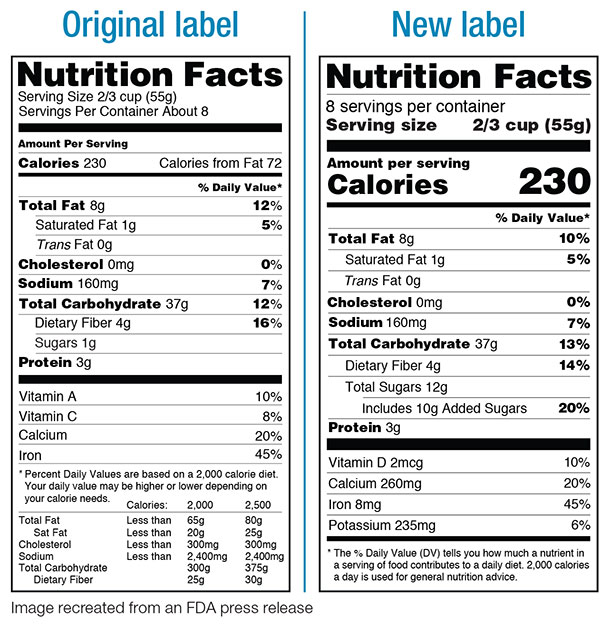The FDA recently released its nutrition facts side panel for all packaged foods and beverages. A new requirement of the redesigned panel is the labeling of “added sugars” in both grams and as a percent of suggested daily value intake. Although it is still too early to tell exactly how the added sugar label on sweetened dairy products will be perceived by consumers, industry leaders are concerned consumers will only focus on the added sugar component and not on the nutrient-rich value of dairy foods.

The most common sweetened dairy products are flavored milks, eggnog, yogurts and ice cream, says Cary Frye, the International Dairy Foods Association’s vice president for regulatory and scientific affairs. The types of ingredients listed as added sugars in these products are sucrose, honey or high fructose corn syrup. Frye says it is important to have these sweeteners in dairy products, such as ice cream to help with freezing.
Dr. Kristin Harris, vice president of regulatory affairs for the National Dairy Council, says when the FDA released its supplemental proposal for the labeling of added sugar, it indicated in research that when consumers were shown different yogurt products with added sugar on the labels, the presence of the added sugar label caused consumers to view the product as less healthy, regardless of the overall nutrition profile.
“It would be concerning to us if consumers are really just focusing in on that added sugar component and not taking in all of the information that is on the panel,” Harris says.
In addition to the new added sugar line item of the label, changes were made to the nutrition facts panel to increase the font size for calories, servings per container and serving size, as well as bolding the number of calories and serving size to highlight this information. Other changes included updating recommended serving sizes and the daily values for nutrients, requiring vitamin D and potassium to be listed on the label, and changing the label’s footnote to better explain what percent daily value means.
It is important that consumers not look at one single nutrient such as sugar, but look at the package as a whole, Harris says. Consumers need to understand the nutrient-rich value of dairy foods and look at sugar in relation to the other essential nutrients dairy products can offer. Therefore, Harris says it is important for the Dairy Council to continue consumer education on the nutritional value of dairy products because most Americans are not consuming the recommended three servings of dairy a day.
Frye says the total amount of sugar in a product was already listed on the old nutrition facts panels, and now, because it will be split into two lines on the new labels, it will give consumers more information to make more informed choices.
“I personally don’t think the declaration of added sugars is going to defer people to switch,” Frye says. “I think different people switch and seek out lower sugar products for many different reasons. But I don’t think this will defer them to switch because we already currently have these amounts of sugar in our products listed as total sugars.”
With the new FDA label, Frye says the new component is an advantage because consumers will clearly know which part of the milk product is a natural sugar, such as lactose, and which part is added.
The nutrition facts label is there to provide information to consumers to help them follow healthy dietary practices, Harris says. Consumers can use the added sugar information in a number of ways depending on their personal preferences. She says different consumers may be seeking more or less added sugars depending on their individual needs.
“You may be an athlete who is looking for a certain amount of carbohydrates in the form of sugar to refuel after a workout, or you may be a mom seeking products with lower amounts of added sugar for her family,” Harris says. “This information simply helps the consumer make informed consumption and purchase decisions.”
With the new FDA labels going into effect in two years, Frye says dairy processors are going to have to comply with the new nutrition facts panels soon. If consumers find certain dairy products too high in added sugar, dairy processors may have to consider revising their recipes.
“If they make a product that includes a sweetener, processors could say, ‘Well, do I have alternatives?’” Frye says. “If they are concerned with added sugars, they could look at reformulating.”
According to Frye, some changes processors could take are using a different type of sweetener or changing to a blend of a lower nutritive sweetener.
Harris says the dairy industry has already done a lot of work to reduce added sugars in dairy products.
“Since 2007 the dairy industry has reduced added sugars by 55 percent. Especially in flavored milks served in schools,” Harris says. “I would anticipate that this will be viewed positively.”
It may take a long time for a change like this to have an impact, and it is hard to tell exactly how consumers will react to the new added sugar label.
The nutrition facts label will go into effect July 26, 2018, for food and beverage manufacturers with sales greater than $10 million. Companies with sales less than $10 million will have an additional year to comply with the new rules. PD






